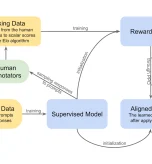Artificial Intelligence is a transformative technology that has found its way into various aspects of our lives, from voice assistants on our smartphones to autonomous vehicles navigating our streets. But have you ever wondered how AI systems learn and improve their performance? The answer lies in the crucial role of AI training data.
An AI project without a good training data set simply won’t perform its intended function. But creating a good AI training data set is no easy task. In this article, we’ll delve deep into the world of AI training data, exploring its significance and how it’s used in the realm of machine learning. So stick with us.
What Is AI Model Training?
Before we dive into the specifics of AI training data for machine learning systems, let’s first understand the concept of AI model training. An AI model is essentially a computer program designed to perform a specific task, such as recognizing images, translating languages, or playing chess.
However, unlike traditional software, machine learning models don’t rely solely on a rule-based system where a programmer inputs a list of rules and facts in the form of if-then statements that the program must follow. Instead, these types of models learn from training data, independently analyze the information, and provide unique outputs.
AI model training is the process of teaching these models to make predictions or decisions by exposing them to large amounts of data. The model learns patterns and correlations from this data, enabling it to generalize and perform tasks it hasn’t seen before.
Think of it as teaching a child to identify animals by showing them pictures of various creatures – the more diverse and representative the pictures, the better the child becomes at recognizing animals.
What Is Artificial Intelligence Training Data?
At the heart of AI model training is the training data. Artificial Intelligence training data is the raw material from which AI models learn. It comprises various data points, such as text, images, audio, or sensor readings, depending on the nature of the AI task. This data is carefully selected and prepared to ensure the model’s effectiveness.
The Three Types of Machine Learning Models
Let’s take a second here to explain the three different methods of machine learning, as they relate to the type of AI training data that is used:
- Supervised learning: the training data is essential and must be accompanied by labels. These labels enable the model to grasp the relationship between specific attributes and their corresponding labels.
- Unsupervised learning: there is no need for labels within the training dataset. In unsupervised learning, the machine learning model seeks inherent patterns or structures among the attributes to formulate generalized groupings or predictions.
- Semi-supervised learning: Uses a hybrid training dataset containing a mixture of unlabeled and labeled features, catering to the unique challenges posed by semi-supervised learning problems.
Another technique that can be applied to these three models is reinforced learning. Reinforced learning refers to providing rewards or penalties for the outputs an AI model gives, thus teaching it in a reiterative process.
What Is Labeled Data?
Labeled data is a subset of AI training data that is annotated or tagged with relevant information. In other words, each data point is accompanied by a label or tag that specifies what the data represents. For example, for image recognition, you would need image annotation with descriptions of what objects or features are present in each image.
Labeled data is incredibly valuable for training AI models because it provides clear examples of the task the model is supposed to perform. It’s like providing a child with labels for the animals in the pictures we discussed, making it easier for them to learn and recognize different creatures. Labeled data is always used for supervised or semi-supervised training of machine learning models.

What Is Human-In-The-Loop?
Human-in-the-loop (HITL) is a concept that involves human oversight and intervention in the AI training process. While AI models can learn from pure data, they are not infallible and can make mistakes. Human experts are often involved in reviewing and correcting the model’s predictions, especially when the consequences of errors are significant.
Human-in-the-loop is associated with reinforced learning. HITL is crucial in scenarios where precision and accuracy are paramount and there is a need for true human intelligence, such as medical diagnosis or self-driving cars. It ensures that AI models are continually refined and improved with the help of human expertise.
The Importance of Good Data
The saying “garbage in, garbage out” holds very true in the world of AI. The quality of AI training data significantly influences the performance and reliability of Artificial Intelligence systems. If a model is trained on bad data, it won’t perform its intended function. Here are some key reasons why good data is paramount:
Avoiding Bias
Biased data can lead to biased AI models. If the training data contains unfair or unrepresentative samples, the AI model may inherit these biases and make unfair decisions. Ensuring diverse and unbiased data is critical for having AI with high levels of performance.
Enhancing Accuracy
Accurate training data, unsurprisingly, is essential for training AI models to perform well. Inaccurate or noisy data can lead to incorrect predictions and unreliable results.
Improving Generalization
High-quality data enables AI models to generalize better. This means they can apply their learning to new, unseen situations with a greater level of accuracy and confidence.
Reducing Training Time
Good data can significantly reduce the time required to train an AI model. When the data is clean and well-prepared, the model can learn faster and achieve better performance more quickly.
How Is Training Data Used in Machine Learning?
Now that we’ve explored the types and significance of high-quality AI training data, let’s delve into how this data is used in the machine learning process.
Preparing Training Data
The first step is data preprocessing. This involves cleaning the data to remove errors, inconsistencies, or irrelevant information. It also includes transforming the data into a format suitable for training the AI model. For example, text data may be tokenized or images may be resized and normalized.
Additionally, data augmentation techniques may be applied to increase the diversity if the volume of training data is low. In image recognition, for instance, you can create new training examples by rotating, cropping, or adding noise to existing images. This helps the model generalize better and become more robust.
Testing and Validating Training Data
Before training an AI model, it’s essential to split the training data into two subsets: the training set and the testing set. The training set is used to teach the model, while the validation set is used to assess its performance during training.
Validation/testing data helps in fine-tuning the model’s hyperparameters and preventing overfitting (or underfitting). Overfitting occurs when a model becomes too specialized in its training data and performs poorly on new, unseen data. Underfitting is the converse.
The testing data should be distinct from the training data and should not be used during the model’s training process. It serves as a benchmark to measure the model’s performance level, precision, recall, and other metrics. If the model performs well on testing data, it is more likely to perform well in real-world applications.
How Can You Get Training Data?
Acquiring high-quality training data is often a challenging and resource-intensive task. Here are some common methods for obtaining training data:
- Data Collection: You can collect your own data by using sensors, surveys, or data scraping techniques. This approach allows you to tailor the data to your specific needs.
- Public Datasets: Many organizations and research institutions provide publicly available datasets for various AI tasks. Some examples are ImageNet for image classification and the Common Crawl dataset for web text.
- Data Labeling Services: If you need labeled data, you can enlist the help of data labeling services. These services employ human annotators to label data according to your specifications.
- Data Partnerships: Collaboration with other organizations or data providers can be a valuable source of training data. It may involve data-sharing agreements or partnerships for data collection.
- Synthetic Data Generation: In some cases, you can generate synthetic data to supplement your training set. This is particularly useful when real-world data is scarce or expensive to obtain.
At the end of the day, AI training data is the lifeblood of machine learning algorithms. It is what allows AI models to learn and make informed decisions while the quality of AI training data determines the accuracy, fairness, and generalization capabilities of AI systems.
If you need to acquire high-quality training data sets for your AI projects, Aya Data can help. We provide services all across the AI pipeline – starting with data acquisition and data annotation. We can help you deploy and manage AI solutions. If you need it, we can even create custom AI models for any type of project you are working on.
Schedule a free consultation with one of our experts to discuss how Aya can contribute to your project.
Frequently Asked Questions (FAQ)
What is training data for generative AI and why is it essential?
Training data for generative AI includes vast datasets of text, images, or audio that models like GPT, Gemini, Claude, Grok etc.. use to learn patterns for creating new and improved content. It’s essential for understanding context and styles, preventing incoherent outputs.
How can you effectively collect data for AI training projects?
Collect AI training data by defining needs (e.g., labeled images for vision tasks), using ethical web scraping, buying from Kaggle, or crowdsourcing via Mechanical Turk. Ensure GDPR compliance, diversity, and cleaning to remove errors. This boosts model efficiency.
What exactly is AI training data and how does it differ from regular data?
AI training data is structured and labeled examples (e.g., annotated text) used to teach models via supervised learning. Unlike raw data, it’s preprocessed for relevance, balance, and task-specificity, enabling accurate predictions and generalisation.
Why does AI need training data to function effectively?
AI fully relies on training data for statistical pattern learning, as it lacks innate knowledge. It optimises models through backpropagation to minimise errors, avoiding overfitting.These quality data ensures robustness and adaptability.
What types of data are commonly used to train AI models?
AI training uses structured data (e.g., spreadsheets), unstructured (e.g., text for NLP), and multimodal (e.g., video for recognition). Examples: ImageNet for vision, Wikipedia for language. Selection depends on goals, emphasising volume and diversity.
What is the role of training data in the AI development process?
Training data optimises models by providing examples for parameter adjustments in pre-training and fine-tuning. It supports validation and testing, ensuring performance which aids in ethical sourcing to prevent biases for reliable AI.
Where does AI training data typically come from in practice?
Sources include public repos (UCI), web crawls, user content (with consent), or synthetic data from GANs. Companies outsourcing labeling or using internal data are advised to focus on legality and diversity to avoid skewed results.
How does AI learn from training data during the training process?
AI learns by processing data in batches via gradient descent, adjusting internal weights to minimize prediction errors. Supervised learning uses labeled data, while unsupervised learning finds patterns in unlabeled data. TensorFlow monitors this, ensuring the AI generalises effectively.
What makes training data “good” for building effective AI models?
Good data is accurate, diverse, balanced, clean and free of biases, errors, or duplicates with proper labeling. This improves precision, recall, and fairness, minimising and retraining needs for applications like healthcare.
How do you build and use training datasets for custom AI applications?
Build datasets by defining objectives, gathering from APIs, preprocessing (cleaning, labeling with LabelStudio), and splitting (80/10/10). Augment for scarcity; use PyTorch for integration. Anonymise sensitive data for compliance and performance.






